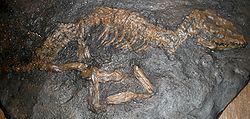| Proviverrinae Temporal range: Early to Late Eocene | |
|---|---|
 | |
| Fossil of Lesmesodon edingeri | |
 | |
| Skull of Proviverra typica | |
| Scientific classification | |
| Kingdom: | Animalia |
| Phylum: | Chordata |
| Class: | Mammalia |
| Order: | † Hyaenodonta |
| Superfamily: | † Hyaenodontoidea |
| Clade: | † Proviverrinae Schlosser, 1886 [1] |
| Type genus | |
| † Proviverra Rütimeyer, 1862 | |
| Genera | |
[see classification] | |
| Synonyms | |
Proviverrinae ("before civets") is an extinct clade of placental mammals within superfamily Hyaenodontoidea in extinct order Hyaenodonta. Fossil remains of these mammals are known from early to late Eocene deposits in Europe. [5] [6] [7] [8] Their decline was thought to have been the result with of competition with carnivorans, hyaenodontines, and hyainailourines. [9] [10]